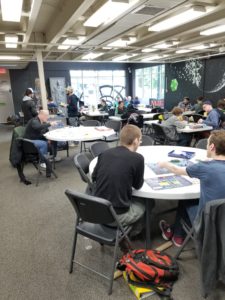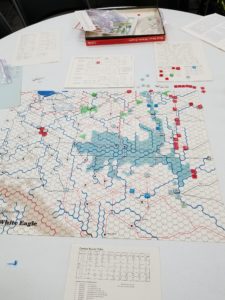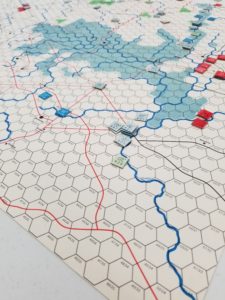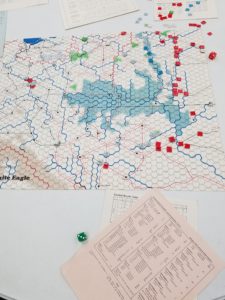Over to Portland for Tim’s birthday and some wargaming at Guardian Games.
Fun place. You can game, drink beer, and when it’s your opponent’s turn, look at the inventory. It’s not a wargame store, but they do have some games, along with Flames of War miniatures.
Lots of diverse Portlandians playing a wide variety of games. However, the fellow next to us playing D&D using different voices for each character was a bit difficult to handle.

Played Red Star/White Eagle, an old GDW Russo-Polish War game. Mechanics similar to Europa, but with period chrome. An earlier session attained legendary status due to a rules gaffe changing it from a fluid, fast and fun game to a static, boring slogging match. We misinterpreted the CRT. I’ll leave it at that.
That CRT is bloody. Most casualty results also require retreats of several hexes, with opponent able to pursue. There are no outright ZOC kills, but many units have a intrinsic “delay” factor, forcing a retreating unit that pass by them to roll for casualties on a separate table. Literally double jeopardy.
Tim played the Poles (blue counters).

It’s a big map with relatively low counter density. The Soviets have two armies, which cannot cooperate, located in the north and south, respectively. The map’s center is dominated by marshy terrain, significantly reducing movement, with rivers creating east-west compartments. As you can see, the mandated initial set-up for the campaign game places both side’s units facing each other in the East. Victory is determined by city occupation.
Both Soviet and Polish armies are mobile, with most units having much higher attack than defense factors. Mobility is assisted by rail networks.
Each side receives significant replacements. These factors are represented by special counters which must be in the same hex as an active counter during the reinforcement and replacement phase of a game turn. So, some planning and management is required to reinforce reduced strength units.
The northern Polish and Soviet units have limited movement and attack options for the first three turns, so early action occurs in the south. Also, the Polish player must capture Kiev early, or lose his Ukrainian troops. Tim attained this objective and gained 6 victory points.

By Turn 4, both sides are free of movement restrictions and by Turn 6, the Soviets have received the Konarmiya reinforcements. This is a corps of cavalry and mechanized units, with extremely high attack factors and a charge bonus. To gain this bonus, the unit(s) must begin their movement outside a Polish ZOC.
I pushed my Konarmiya south of Kiev, maintaining sufficient distance from Tim’s Poles. I was afraid that Tim would “ZOC up” the Konarmiya with low strength units to reduce my combat effectiveness.

The attack was successful, but it was time for a big Italian dinner. Just when it was getting interesting.
In summary, this is a fun and challenging game. We will play it again when we meet this summer. No food until game finished!